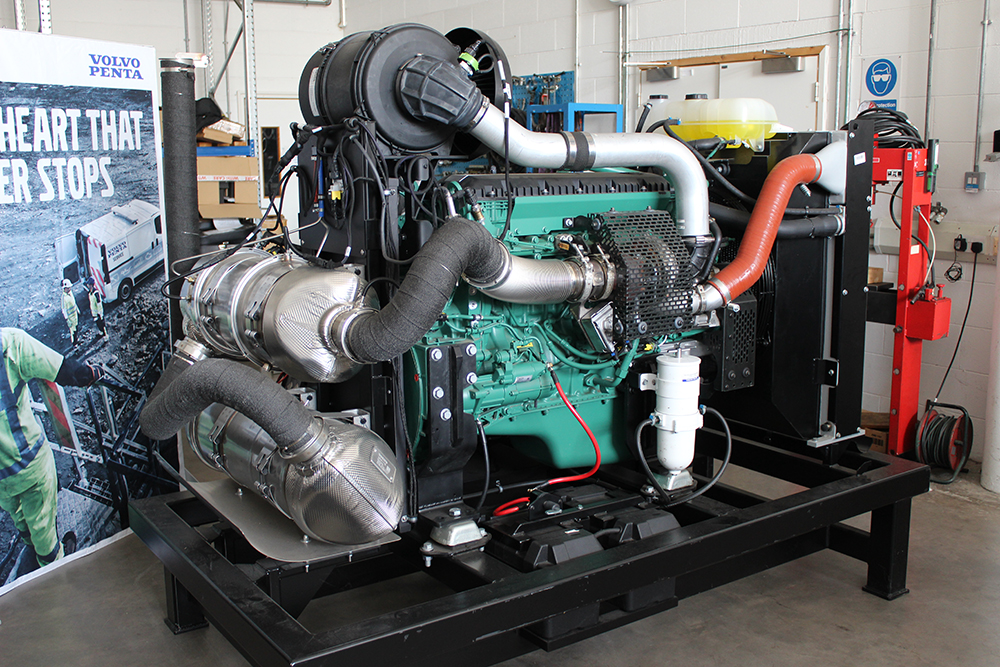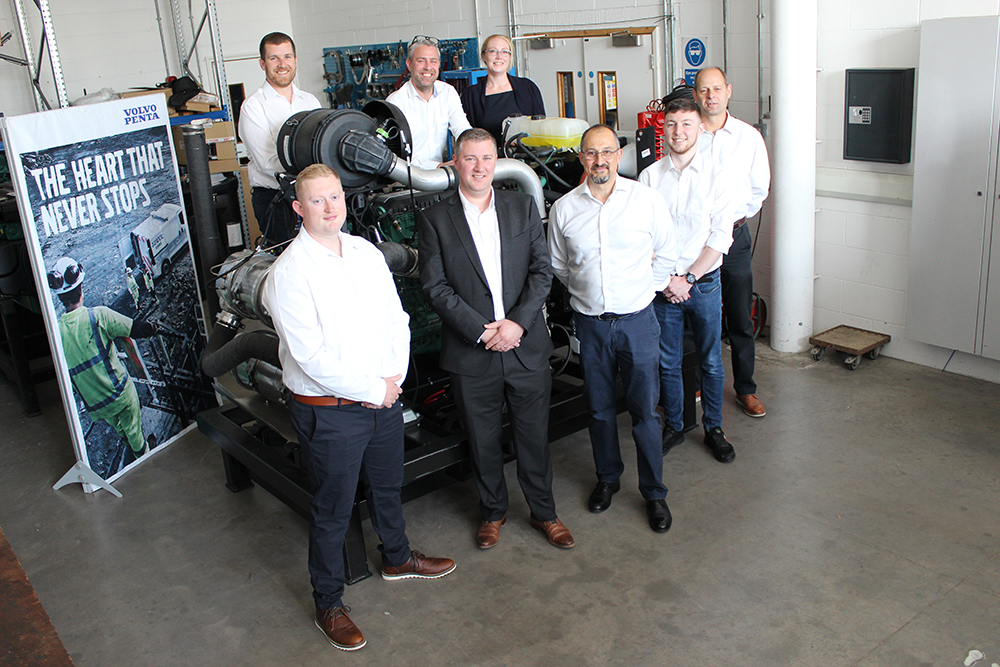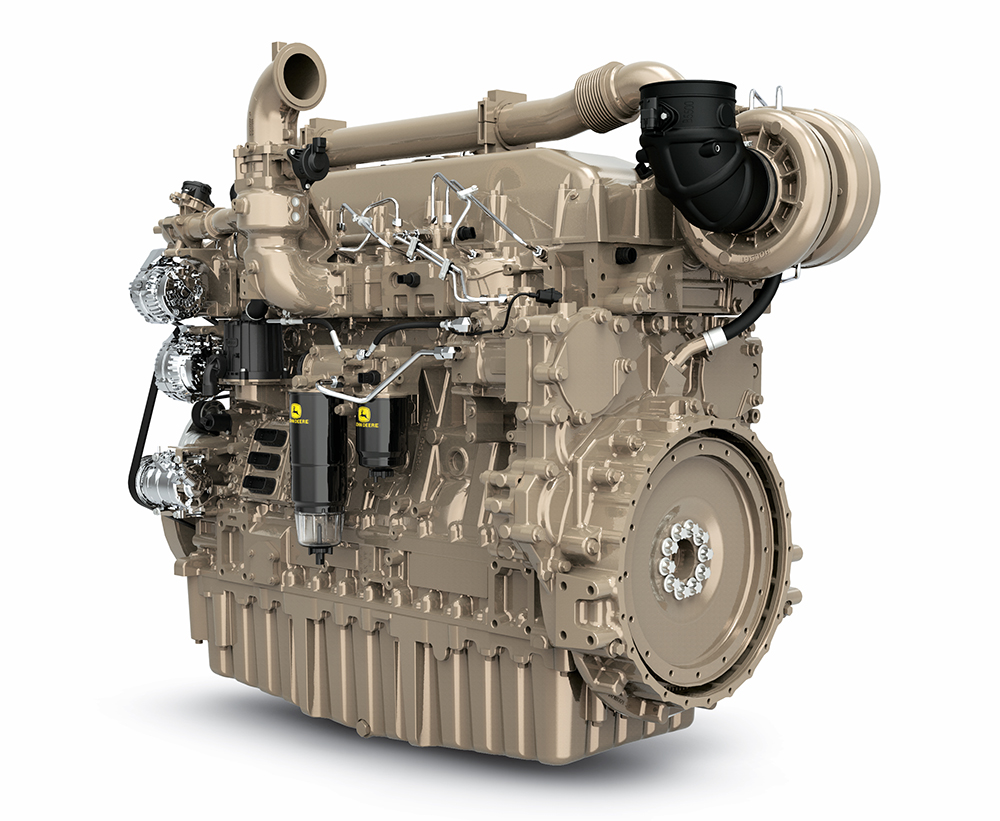
Cummins has been at the cutting edge of developing power solutions for over a hundred years and is continuing this leadership by developing a diverse range of sustainable drivetrains – from clean diesel to natural gas to battery and hydrogen power solutions. At the start of 2022, Cummins announced the expansion of its industry-leading power portfolio with the launch of fuel-agnostic internal combustion powertrain solutions.
This is an industry first. These are the first engine platforms to be intentionally designed with commonality in mind for both the engine footprint and components across diesel, natural gas and hydrogen fuels.
This new approach will be applied across Cummins’ B, L, and X-Series engine portfolios, initially in on-road applications but with off-highway use coming soon.
For Cummins, this fuel-agnostic development, alongside its hydrogen fuel production activity, is crucial to achieving the company’s Destination Zero by 2050 commitments. This Cummins pledge will reduce emissions in duty cycles across markets via a range of solutions, as there is no one solution that will work for all application types or all end users and OEMs (original equipment manufacturers).
Creating a diverse power portfolio that can operate using different fuels, with minimal adjustments to engine architecture, enables greater flexibility to OEMs and therefore encourages the use of lower emission fuels.

The agnostic-fuel powertrain solutions will feature a series of engine versions that are derived from a common internal combustion engine, with up to 80% commonality compared to diesel engine counterparts. Below the head gasket of each engine will be largely similar components, and above these head gaskets will be different components matched for different fuel types. Each version will operate using a different, single fuel.
The fuel-agnostic platforms are designed and built following extensive trial and error research, resulting in Cummins' development of millions of diesel and natural gas engines that are currently in use. By designing the three new engine platforms with inherent fuel-agnostic capabilities from the outset, Cummins can avoid performance limitations and efficiency compromise, problems that are often associated with converting existing engine designs.
Fuel-agnostic engine platforms offer a unique combination of benefits to OEMs and fleet owners interested in reducing vehicle emissions. The immediate reduction in carbon emissions, economic viability, and reliability are three of the most critical benefits of fuel-agnostic engines.
The choice between reliability and reduced emissions is not a trade-off. Using a fuel-agnostic engine with internal combustion engines offers a balance of reliability and reduced carbon emissions. In addition, technicians’ existing familiarity with the fuel-agnostic platforms strengthens the day-to-day reliability of these engines, as repairs do not have added layers of complexities from unfamiliar technologies.
Enabling internal combustion engines to become fuel-agnostic brings important advantages for OEMs and fleets:
- Minimal vehicle redesign: Engines within a fuel-agnostic platform have a common product architecture. For OEMs, there is less need to alter vehicle design to accommodate different versions of the same engine family
- Limited manufacturing process changes: The need to re-tool production lines and create manufacturing processes to accommodate engines that are a part of a fuel-agnostic platform is lower than adopting a completely new power technology
- Reduced incremental technician training: Engines within a fuel-agnostic platform look and feel like the products technicians are already familiar with
Annually, Cummins spends US$1 billion on research and technology to help its customers decarbonise. This research and development, supported with a string of acquisitions has identified a diverse range of solutions to decarbonise the power sector. A key focus of this recent Cummins activity and the development of the fuel-agnostic engine platform has been supporting the future of hydrogen in the power sector.
There are three key areas when focusing on hydrogen:
- Production of green hydrogen
- Management and transportation of hydrogen
- Application of hydrogen in engines and fuel cells
As a fuel source, hydrogen is lightweight, easy to store, and capable of providing high energy per unit mass, with no CO2 emissions at the point of use. For hydrogen to be truly emission free, the production of the fuel needs to be “green” i.e., without direct emissions of air pollutants or greenhouse gases. Without hydrogen being green, it cannot be a meaningful part of the solution as we move toward carbon neutrality.
Green hydrogen is produced using electrolysis to turn sustainable power sources (wind, solar, hydro) into hydrogen with zero carbon dioxide emissions.
Companies like Cummins are investing in research to advance electrolyser technology so green hydrogen can be made in a more cost-effective manner, with reduced environmental impact. An example of this can be seen in the partnership between Cummins and Air Liquide to construct the world’s largest proton exchange membrane electrolyser, which is producing up to 8.2 tons per day of low-carbon hydrogen in Québec, Canada.
The use of hydrogen engines will be gradual over the next 10 to 20 years, as it becomes operationally and economically viable for OEMs and operators to transition power solutions. However, current generation diesel technology and other alternative fuel technologies can support this journey.
As a company committed to meeting the world’s sustainability challenges, Cummins continues to deliver a broad portfolio of power solutions that can support OEMs and customers transition to zero-carbon solutions. The firm is at the forefront of driving innovation in the areas of advanced fuel cells, alternative fuels and advanced energy solutions. Cummins continues to develop integrated engine system technologies and controls and is working with partners to integrate its products and services in the autonomous vehicles of the future.
Volvo Penta’s extensive quarrying-suited industrial engines’ portfolio ranges from five-to 16-litre solutions. Speaking to Aggregates Business, Riccardo Sardelli, the company’s industrial sales manager for UK & Ireland, says business is “extraordinarily busy” as the market continues to recover from prolonged COVID-19-induced disruption.
“There is big demand not just in Europe but globally,” he notes. “We are seeing particularly strong interest in our five- and eight-litre engines, and the generator [engine] side of the industrial engines business is up 22-25% on last year. Demand is driven by emissions compliance - moving away from Stage IIIA engines to Stage V solutions is an 83% reduction in NOx [nitrogen oxides], [diesel] particulate and carbon.”

Sardelli says the biggest challenges faced by Volvo Penta and other off-highway machine engine manufacturers are the lack of semiconductor availability and shortages of raw material, such as copper. “A lot of raw material is processed in Russia, and [given the Russia-Ukraine crisis] new supply lines involving different countries are taking time to set up. A lot of shipping containers were also mothballed during the coronavirus pandemic and are in the process of being set back up.”
Commenting on key global regional market differences, Sardelli says smaller eight- and 11-litre engine-powered crushers tend to be preferred in the US quarrying market, with many European customers favouring larger crushers powered by 13- and 16-litre engines. Sardelli explains that these larger engines offer “significantly longer” life cycles.
He adds: “All our engines offer a high-power density for their cubic capacity. The 5-litre unit, for example, is a real torque animal. You don’t need to run it at a higher speed and are in the optimum area for lower fuel consumption.
“We have a dedicated industrial servicing network, so quarry customers are calling out top-tier Grade 3 and 4 technicians that know all about Volvo Penta products and how to diagnose them. That’s important with maintaining machine uptime.”
Sardelli highlights that Volvo Penta is part of the Volvo Group’s engine remanufacturing scheme where customer engines, along with transmissions and axles, can be rebuilt at a dedicated facility in Limoges, France. “A lot of regeneration work is carried out from reman injectors to carbon recovery from DPFs (diesel particulate filters) at the facility, with a lot of carbon recovered from the DPFs and sold back to the plastics industry for processing all kinds of polymers for use by the household appliance and automotive industries.”
Sardelli forecasts more hybridisation in quarrying machine engines, with a combustion engine combined with an electrical system. Furthermore, greater demand for energy-storage systems will allow for fully electric quarry machine operation. “You must be careful with crushing and screening applications as there can be huge plant vibrations, so electric components need to have great resilience. Large battery packs do not like shaking.”
Sardelli says Volvo Penta is working “very diligently” on its net-zero programme. “We are heavily focused on developing renewable technologies for the northern hemisphere, and we cannot ignore demands for the southern hemisphere with lower emission products.”
He notes the continued success of the Electric Quarry project involving Volvo Construction Equipment and Skanska that began five years ago. “Around 17 large, mostly 18-litre diesel engine-powered, rigid dump trucks, and other diesel engine-powered machines were replaced by fully electric or hybrid-powered units powered by two generators. The wheeled loader, for example, was hybrid-powered with a small five-litre engine, and the crushers were electrically driven. The site also ran completely autonomous dump trucks, like skips on wheels. Environmentally, the carbon reduction was huge.”
Sardelli stresses how much he enjoys working as part of a “small, dynamic team” based in the UK. “We have Wendi Goodman looking after generators; Nick Styles working on variable speed; and Sam Thirlaway is our application engineer. We feed into our Service Market Team headed by Tim Barclay, who is supported by Chris Slevin, David Sherry and Jonathan Taylor. This group is very knowledgeable on hybridisation, electrical systems, and hydrogen-powered engines.”
Remaining with Volvo Penta, Morgan Blomgren, director Strategy & Business Development, and Prabhakaran Sundaramurthi, vice president - Product Management Industrial, have spoken to Aggregates Business in more detail about the company’s quarrying-suited industrial engine research and development work.
“In the short-term, the focus is still very much on diesel-powered engines. In this part of the business, we see continued strong demand for diesel engines, and we will continue our development in diesel moving forward, at least past a Stage VI regulation. However, we also see a rising interest in alternative fuels. Besides our engines being able to run on HVO and biodiesel already today, we are also looking into using both CNG, biogas and hydrogen as energy carriers for internal combustion engines.”
Asked about the challenges posed in ensuring sustainability when engineering new off-highway engine solutions, the pair say: “Of course, new technologies always bring some challenges when it comes to engineering. But what we are seeing now is also a challenge in keeping on top of the different regulations when it comes to batteries and new types of fuel. A lot is happening across the globe when it comes to this and it’s extremely important to make sure that the solutions we put on the market are compliant with the various regulations. On the engineering side, we would say that some of the main challenges are to generate enough power to replace one of our bigger diesel engines today and still limit the size and weight of the solution, and also to reach a similar or better total cost of ownership.”
So, when can quarrying customers expect to see new Volvo Penta engines for their machines? “The second part of this decade is when the market can expect new solutions from Volvo Penta in this specific part of the business. We have already started our journey towards zero emissions within the battery-electric area. But we are, in parallel, looking at a wide range of solutions to support our full range of customers. This includes internal combustion engines powered by alternative fuel and hybridisation. These are most likely the transitioning solutions before reaching zero-emission solutions for this segment of the business.”
Commenting on how new quarrying-suited Volvo Penta industrial engines will stand out in a highly competitive marketplace, Blomgren and Sundaramurthi say the company always aims to give customers a solution they can rely on to perform. “To strengthen this even further we will soon provide several different services that maximise uptime and support efficient usage of the engine. This reduces fuel consumption even further.
“We have a solid foundation to stand on with our current diesel offering and together with the rest of the Volvo Group we are sure that we will continue to have strong customer testimonials moving into offerings beyond diesel as well.”

Asked about the feasibility of many future quarry sites being entirely powered by electric, hydrogen and other non-diesel-powered crushers, screeners, loaders and haulers, Blomgren and Sundaramurthi add: “With a combination of the different alternatives mentioned it is quite feasible to see production sites like this in the future, but it will take a combination to achieve it. Electrification has its limits and so have other solutions but bringing them together in a site like this can offer a viable solution with less or even zero emissions.
“The big question is when it will be realistic to reach zero emissions. And that is most likely the million-dollar question here. One of the keys to making it happen is of course the availability of alternative fuels, like hydrogen, HVO, and biogas. This in combination with the electricity supply is what will determine the speed of transformation in the industry. There are ambitious plans for this across Europe and in other areas of the globe, but we are looking at the 2030 timeframe to reach sufficient levels of supply. Reaching a high enough supply is also a key to reaching a price level for the fuel that makes it a realistic option in a fuel-consuming business like this [quarrying].”
John Deere Power Systems (Deere) is constantly innovating ways to meet both market and customer demands to deliver new levels of reliability, durability, flexibility, and serviceability. The result is a comprehensive engine lineup for a wide array of heavy-duty applications. The newest addition to the next-generation Deere industrial engines is the 18-litre JD18 engine.
Featuring uptime-focused controls that offer improved diagnostic capabilities, users are able to quickly target the source of a performance issue and get back to work. The JD18 features a bedplate design, providing structural benefits for extreme durability, with the ability to be re-built two times. The engine also has Hydraulic Lash Adjustment (HLAs), which offers a maintenance-free valvetrain, eliminating the need to reset the lash.
New combustion technology means John Deere can offer an engine in the 522 – 676kW power range without aftertreatment, so users have one less fluid to manage. The high-pressure common-rail fuel system in the JD18 allows the engine to deliver optimised fluid consumption. Plus, the Diamond-Like Coating (DLC) improves bio-diesel compatibility and system robustness.
With the addition of the JD18, users can put John Deere power and performance into their entire line-up of equipment from 36kW to 676kW. OEMs are encouraged to contact their local John Deere engine distributor or dealer for more information on the JD18.
Building on its experience in integrating smart and sustainable technology innovations into powertrain systems, Deere has made strategic investments in two companies that are leveraging unique technologies for alternative fuel and electrification solutions.
In late 2021, Deere made an equity investment in ClearFlame Engine Technologies, a growing start-up dedicated to the development of clean engine technology. ClearFlame’s solution enables low-carbon fuels like ethanol to be easily integrated into compression ignition engines, offering a more sustainable solution without compromising engine performance.
In early 2022, Deere also acquired majority ownership in Kreisel Electric, Inc. (Kreisel), a battery-technology provider based in Rainbach im Mühlkreis, Austria. Kreisel develops high-density, high-durability electric-battery modules and packs. Additionally, Kreisel has developed a charging-infrastructure platform (CHIMERO) that utilises this patented battery technology.
This investment in Kreisel provides optimal integration for Deere to efficiently design vehicles and powertrains around superior immersion-cooled, high-density battery technology. Kreisel’s in-market experience combined with the global footprint of Deere is a powerful combination that will leave both companies better equipped to meet the growing demand for electrification.
Deere intends to continue to invest in and develop technologies to innovate, deliver value to customers, and work towards a future with zero-emissions propulsion systems.
Deere’s UK distributor, EP BARRUS, is due to showcase the company’s current Stage V engine range on stand G15 at Hillhead 2022 (21-23 June) near Buxton, England.
Kohler to use HVO in all Europe diesel engines
Kohler Engines has approved the use of EN15940-compliant hydrotreated vegetable oils (HVOs) for all its diesel engines in Europe.
The manufacturer says the use of HVOs, either pure or as a blend with conventional diesel, is part of its commitment to lessen the environmental impact of its engines. The approval came after intensive laboratory and on-the-field testing by Kohler’s engineering team.
The group says its diesel engines do not require any kind of modification or specific upgrade to use HVO. However, use of exhaust gas after-treatment systems will still be necessary where already required.
HVO is a renewable paraffinic fuel, also known under the names 'synthetic diesel' and 'renewable diesel'. It is produced with plant or animal oils derived from the residues of the meat and fish industries.
Since it is obtained from organic material, HVO – unlike biodiesel – does not use agricultural resources or contribute to deforestation. It can be used wherever diesel fuel is used today.
Kohler says a reduction in overall CO2 emissions of up to 90% can be obtained depending on the raw material employed in HVO production. It adds that, compared to most conventional diesel fuels, HVO has an exceptionally low sulphur content and its use leads to lower vehicle exhaust emissions.
Synthetic diesel is widely available in service stations across northern Europe and Kohler says it is taking hold as the next-generation fuel. It is 100% fossil-fuel free and 100% recycled. HVO fuel can be distributed, handled, and stored just like any conventional fuel.













